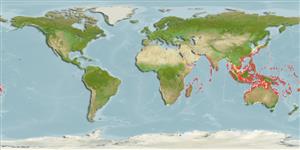Classification / Names
Common names from other countries
Main reference
Size / Weight / Age
Max length : 300 cm TL male/unsexed; (Ref. 9710)
Environment
Marine; brackish; reef-associated; depth range 1 - 50 m (Ref. 90102)
Climate / Range
Tropical, preferred ?
Distribution
Short description
Dorsal
spines
(total): 0;
Dorsal
soft rays
(total): 0;
Anal
spines: 0;
Anal
soft rays: 0;
Vertebrae: 138 - 144. Basically white with black blotches and interspaces forming a honeycomb pattern (Ref. 30404, 48635). Some individuals have a near black overall appearance (Ref. 48635). Blotches variable between individuals and size, often in relation to habitat - those in clear coral reefs usually have proportionally less black than those found in turbid waters (Ref. 30404).
IUCN Red List Status (Ref. 115185)
Threat to humans
Reports of ciguatera poisoning (Ref. 4537)
Human uses
Fisheries: minor commercial; aquarium: public aquariums
More information
Common namesSynonymsMetabolismPredatorsEcotoxicologyReproductionMaturitySpawningFecundityEggsEgg development
ReferencesAquacultureAquaculture profileStrainsGeneticsAllele frequenciesHeritabilityDiseasesProcessingMass conversion
Tools
Special reports
Download XML
Internet sources
Estimates of some properties based on models
Phylogenetic diversity index
PD50 = 0.5000 many relatives (e.g. carps) 0.5 - 2.0 few relatives (e.g. lungfishes)
Trophic Level
4.2 ±0.64 se; Based on food items.
Resilience
Very Low, minimum population doubling time more than 14 years (Preliminary K or Fecundity.)
Vulnerability
Very high vulnerability (85 of 100)
Price category
